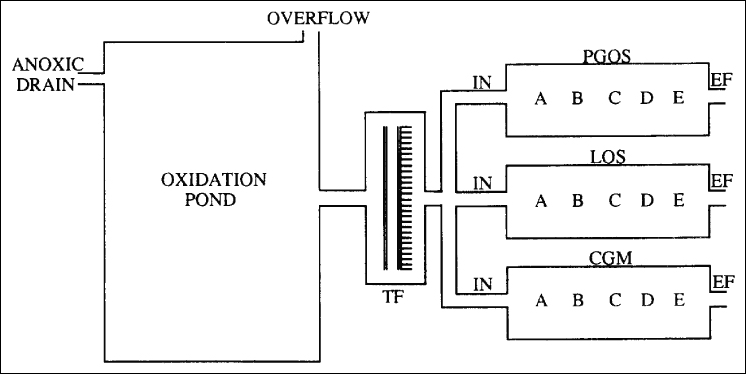Case Study as part of a Web-based
Technical and Regulatory Guidance
Abandoned Coal Mine Site
Tennessee Valley Authority, Alabama
1. Site Information
1.1 Contacts
Valentine Nzengung
PLANTECO Environmental Consultants, LLC
337 South Milledge Avenue
Suite 202, Athens, GA 30605
Telephone: 706-316-3525
www.planteco.com
1.2 Name, Location, and Description
A field pond is receiving effluent from this abandoned Tennessee Valley
Authority (TVA) coal mine site in Alabama. The pilot-scale study was conducted
at the Fabius Coal Mine in northeast Alabama.
2. Remedial Action and Technologies
Acid mine drainage flows from an underground seep through an anoxic drain to
an oxidation pond and then a trickling filter to be distributed among three
treatment ponds for manganese reduction before release to a surface stream
(Figure 2-1).

Figure 2-1. Oxidation pond. TF = trickling filter, IN = influent water, A–E = additional sample points for manganese, CGM = cynobacteria-algae mat pond, LOS = limestone/Oscillatoria pond, PGOS: pea gravel/Oscillatoria pond. Not drawn to scale.
Adapted from Phillips et al. 1995.
The goal of the study was to determine whether an integrated microbial (dominated by cynobacteria or blue-green algae) and green algae mat would effectively remove residual manganese (Mn) in a very small pond surface area. Mn levels ranged 4–9 mg/L and averaged approximately 8 mg/L after leaving an oxidation pond and before draining towards an extensive constructed wetland.
During the three-year field trial, comparisons in Mn removal were made among three 40 m2 ponds: algae mat pond with limestone substrate, a pond with limestone substrate, and a pond with pea gravel substrate. The latter two ponds contained no microbial mat but became infested by the cyanobacteria (Oscillatoria spp.) during the operation phase. All ponds were lined with PVC membrane. The maximum trough water depth and flow rates were 1 ft and 16 L/min, respectively. The mine water flowed from the oxidation pond to a trickling filter (TF), both designed to precipitate ferric hydroxide (Fe(OH)3. From the trickling filters the water was fed to the three ponds (see Figure 2-1). The ponds operated 1992–1995.
The cyanobacteria-algae mat (CGM) pond was seeded with the microbial mat slurry (blended in water) by broadcasting over the pond in three applications during a four-week period, and silage prepared from grass clippings was supplied.
The limestone/Oscillatoria (LOS) pond was not intentionally seeded with cyanobacteria, but became covered with a thin (<1 mm) film of cynobacteria that spread from CGM and covered the limestone. Approximately 10% of pond surface became covered with algae within two months, which later died in December 1992. During the operation phase, precipitated iron covered the entire limestone substrate.
The pea gravel/Oscillatoria (PGOS) pond was not intentionally seeded with cyanobacteria but became covered with a thin (<1 mm) film of cyanobacteria.3. Performance
A thick (1–2 cm) green mat composed of filamentous green algae and cynobacteria,
predominantly Oscillatoria spp., was established and covered the
entire pond surface within two months. The limestone underneath was also
covered with a thick green coating of cynobacteria. Thus, the contaminated
water flowed between the two mat layers. The substrate in the two uninoculated
ponds designed as controls became covered with a thin layer of cynobacteria
(Oscillatoria strain resembling that of the inoculated CGM). A small
amount of floating mat was observed but remain small compared to CGM.
Manganese was more effectively removed from the integrated green algae and microbial mat with limestone substrate pond (algae mat system) than from control ponds containing limestone or pea gravel substrates without small amounts of the mat. Although there was some Mn-cell binding, manganese was primarily deposited as precipitates at the pond bottom. A crystalline manganous deposit collected at the bottom of the pond was identified by X-ray diffraction analysis to be manganese calcite. Day/night and winter/summer manganese removal was essentially the same. The highest efficiency in Mn removal by the algae mat pond (CGM) was most pronounced at higher flow rates and during the night. At 2 m from the influent point of each pond, the algae mat pond removed 2.59 g Mn/day/m2, compared to 0.80 in the limestone pond and 0.37 in the pea gravel pond. Meanwhile, the control ponds (PGOS and LOS) showed either Mn breakthrough or near breakthrough (i.e., Mn outflow releases > USEPA regulations of 2 mg/L during night-time sampling or when drainage flow exceeded 4.5 L/min).
No release of manganese above 0.5 ppm was observed at the outflow during the duration of the pilot test. Because pH remained high in the presence of the photosynthesizing mats, the possibility of remobilization of the manganese is minimal.4. Costs
Specific treatment costs are not available but were generally comparable
to the costs of the treatment wetlands installed by TVA at the site.
5. Regulatory
Challenges
No regulatory challenges were encountered as this was a pilot study.
6. Stakeholder
Challenges
No stakeholder challenges were encountered.
7. Other Challenges and Lessons
Learned
Precipitated iron at the effluent pipes was a persistent challenge. The algae
that contaminated the cynobacteria were bleached during operation while microbial
mat remained green and viable. Unlike limestone treatment pond, there was
no visible evidence of iron precipitation in the pond periphery beyond the
effluent pipe.
8. References
Bender, J., J. P. Gould, Y. Vatcharapijarn, S. Young,
and P. Phillips. 1994. “Removal of Zinc and Manganese from Contaminated Water
with Cyanobacterial Mats,” Water Environment Research 66(5):
679–83.
Bender, J., J. R. Washington, B. Graves, P. Phillips, and G. Abotsi. 1994. “Deposit of Zinc and Manganese in an Aqueous Environment Mediated by Microbial Mats,” Water, Air, and Soil Pollution 75(3–4): 195-204.
Phillips, P., and J. Bender. 1995. “Biological Remediation of Mixed Waste by Microbial Mats,” Federal Facilities Environmental Journal 6(3): 77–85.
Phillips, P., J. Bender, R. Simms, S. Rodriguez-Eaton, and C. Britt. 1995. “Manganese Removal from Acid Coal-mine Drainage by a Pond Containing Green Algae and Microbial Mat,” Water Science and Technology 31(12): 161–70.
